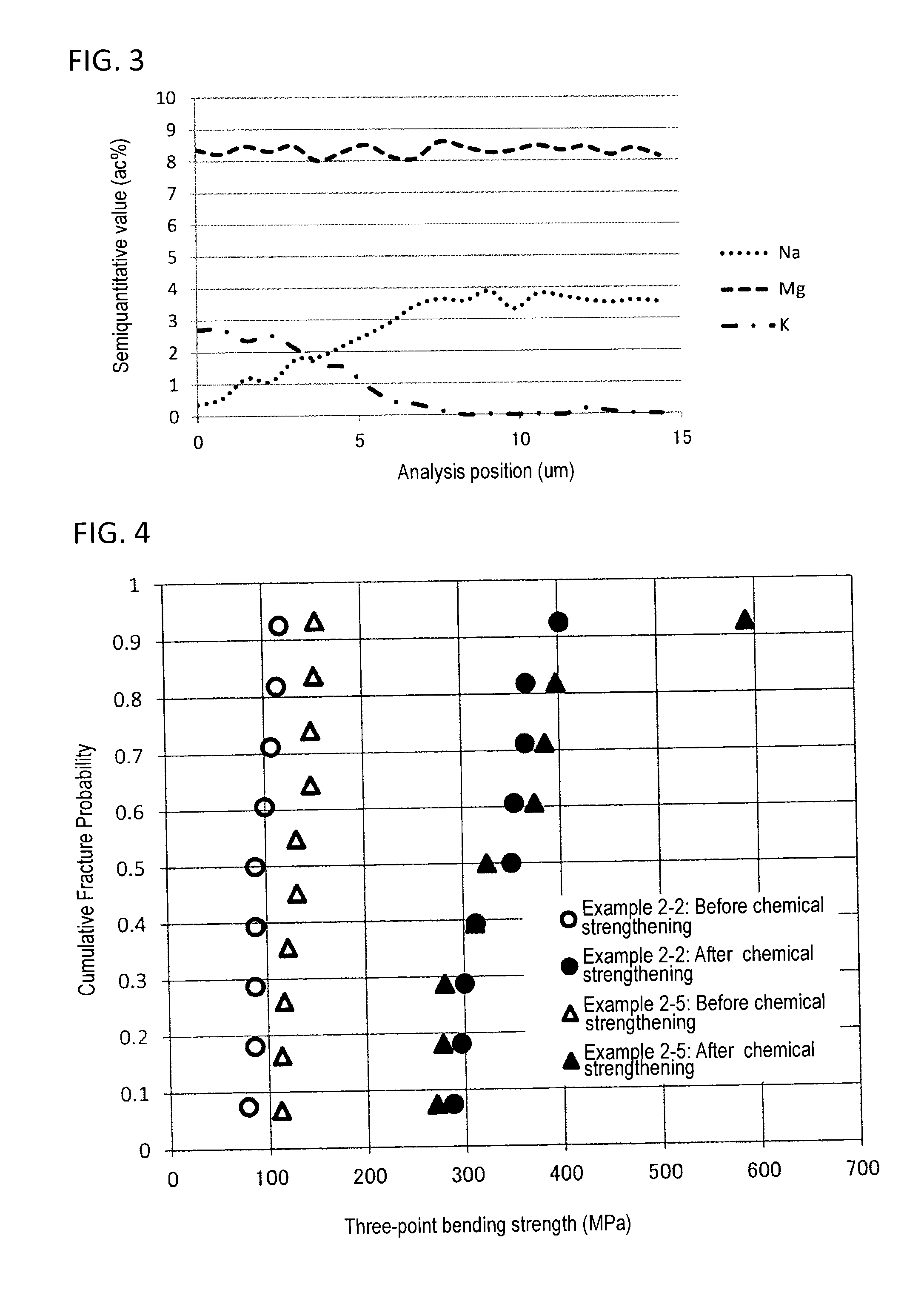Process for producing chemically strengthened glass
a technology of chemical strengthening glass and glass, which is applied in the direction of glass tempering apparatus, instruments, casings/cabinets/drawers details, etc., can solve the problems of increasing the number of steps and the cost, affecting the appearance of the device, and only passing a small portion of light, etc., and achieves excellent shielding properties, high strength, and low cost.
- Summary
- Abstract
- Description
- Claims
- Application Information
AI Technical Summary
Benefits of technology
Problems solved by technology
Method used
Image
Examples
example 1
(1) Heat Treatment (Phase-Separation Treatment)
[0173]A raw material having a composition listed in Table 1 was melted at a temperature of 1650° C. and a sample which was annealed at 730° C. was subjected to a heat treatment. Sodium sulfate having a mass corresponding to 0.1% to 0.4% of the mass was added to the composition listed in Table 1. The mixture was subjected to heat treatment at 900° C. for 4 hours and the phase-separation of the glass was observed using a SEM. The results are shown in FIGS. 1A-1B. FIG. 1A illustrates results of Example 1-1 and FIG. 1B illustrates results of Example 1-2.
[0174]As illustrated in FIGS. 1A-1B, phase-separation occurred in both of Examples 1-1 and 1-2 to thereby obtain a milky white sample. The composition of Example 1-2 was obtained by adding 1 mol % of P2O5 to the case of Example 1-1, but phase-separation occurred at the time when a melt was flown out and whiteness was drastically increased as compared to the case of Example 1-1 by further per...
example 2
(1) Phase-Separation Treatment (Heat Treatment)
[0181]A raw material having a composition listed in Tables 2 to 4 was melted at a temperature of 1650° C. and a sample which was annealed at an annealing temperature listed in Tables 2 to 4 was subjected to a heat treatment and then phase-separated under the conditions listed in Tables 2 to 4. Further, a sample phase-separated in a step of melting, molding, or annealing was described as “non-treated.” The results of measuring transmittance of the obtained sample were shown in Tables 2 to 4 and FIGS. 5A-5C. Moreover, the results of observing the phase-separation state using a SEM were shown in Tables 2 to 4.
[0182]Further, in regard to Examples 2-3, 2-6, and 2-7, the heat treatment for phase-separation was not performed, but the glass was phase-separated with whiteness due to the heat treatment for melting the glass to obtain low transmittance. In addition, the sample of Example 2-2 was the same as the sample of Example 1-1 and the sample...
example 3
[0186]The glass described below was used as crystallized glass, phase-separated glass (binodal), or reference glass.
[0187](1) Crystallized Glass
[0188]The glass having a composition of 50.4% of SiO2, 22.7% of Al2O3, 6.9% of TiO2, 12.5% of Na2O, and 7.5% of K2O as represented by mol % basis was subjected to the heat treatment at 850° C. for 4 hours, and then, the glass which was subjected to the heat treatment at 1100° C. for 4 hours, thereby obtaining crystallized glass.
[0189]The crystallized glass was chemically strengthened through the ion exchange treatment with KNO3 at 450° C. for 30 hours.
[0190](2) Phase-Separated Glass
[0191]The glass having a composition of 59.7% of SiO2, 3.3% of Al2O3, 3.9% of B2O3, 14.9% of MgO, 4.1% of ZrO2, 9.1% of Na2O, and 5.0% of P2O5 as represented by mol % was subjected to the heat treatment at 900° C. for 4 hours, thereby obtaining phase-separated glass.
[0192]The phase-separated glass was chemically strengthened through the ion exchange treatment with...
PUM
| Property | Measurement | Unit |
|---|---|---|
| Weight | aaaaa | aaaaa |
| Weight | aaaaa | aaaaa |
| Time | aaaaa | aaaaa |
Abstract
Description
Claims
Application Information
 Login to View More
Login to View More - R&D
- Intellectual Property
- Life Sciences
- Materials
- Tech Scout
- Unparalleled Data Quality
- Higher Quality Content
- 60% Fewer Hallucinations
Browse by: Latest US Patents, China's latest patents, Technical Efficacy Thesaurus, Application Domain, Technology Topic, Popular Technical Reports.
© 2025 PatSnap. All rights reserved.Legal|Privacy policy|Modern Slavery Act Transparency Statement|Sitemap|About US| Contact US: help@patsnap.com



